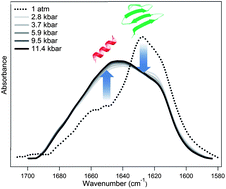Sequential dissociation of insulin amyloids probed by high pressure Fourier transform infrared spectroscopy
Abstract
High pressure (HP) Fourier transform infrared (

Maintenance work is planned for Wednesday 1st May 2024 from 9:00am to 11:00am (BST).
During this time, the performance of our website may be affected - searches may run slowly and some pages may be temporarily unavailable. If this happens, please try refreshing your web browser or try waiting two to three minutes before trying again.
We apologise for any inconvenience this might cause and thank you for your patience.
* Corresponding authors
a Physics Dept of Università degli studi di Trieste, Via Valerio 2, 34127 Trieste, Italy
b
ELETTRA Sincrotrone Trieste, SS14 km 163.5, 34149 Trieste, Italy
E-mail:
andrea.perucchi@elettra.trieste.it
c CNR-IOM, Physics Dept, Ple Aldo Moro 2, 00100 Roma, Italy
d Sapienza Università di Roma, Ple Aldo Moro 2, 00100 Roma, Italy
e Physics Dept, Università degli studi di Palermo, via Archirafi 36, 90123 Palermo, Italy
High pressure (HP) Fourier transform infrared (

 Please wait while we load your content...
Something went wrong. Try again?
Please wait while we load your content...
Something went wrong. Try again?
F. Piccirilli, S. Mangialardo, P. Postorino, L. Baldassarre, S. Lupi and A. Perucchi, Soft Matter, 2012, 8, 11863 DOI: 10.1039/C2SM26297E
To request permission to reproduce material from this article, please go to the Copyright Clearance Center request page.
If you are an author contributing to an RSC publication, you do not need to request permission provided correct acknowledgement is given.
If you are the author of this article, you do not need to request permission to reproduce figures and diagrams provided correct acknowledgement is given. If you want to reproduce the whole article in a third-party publication (excluding your thesis/dissertation for which permission is not required) please go to the Copyright Clearance Center request page.
Read more about how to correctly acknowledge RSC content.
 Fetching data from CrossRef.
Fetching data from CrossRef.
This may take some time to load.
Loading related content
